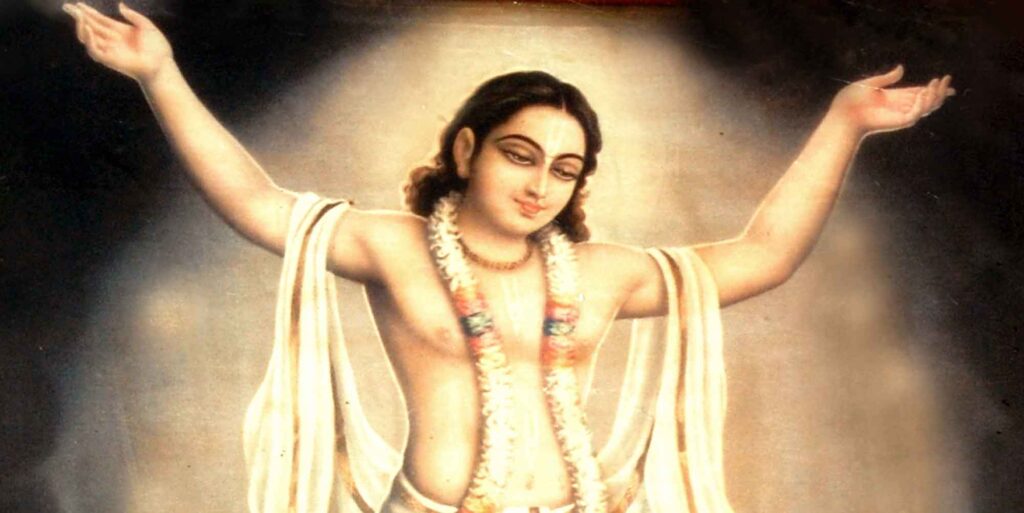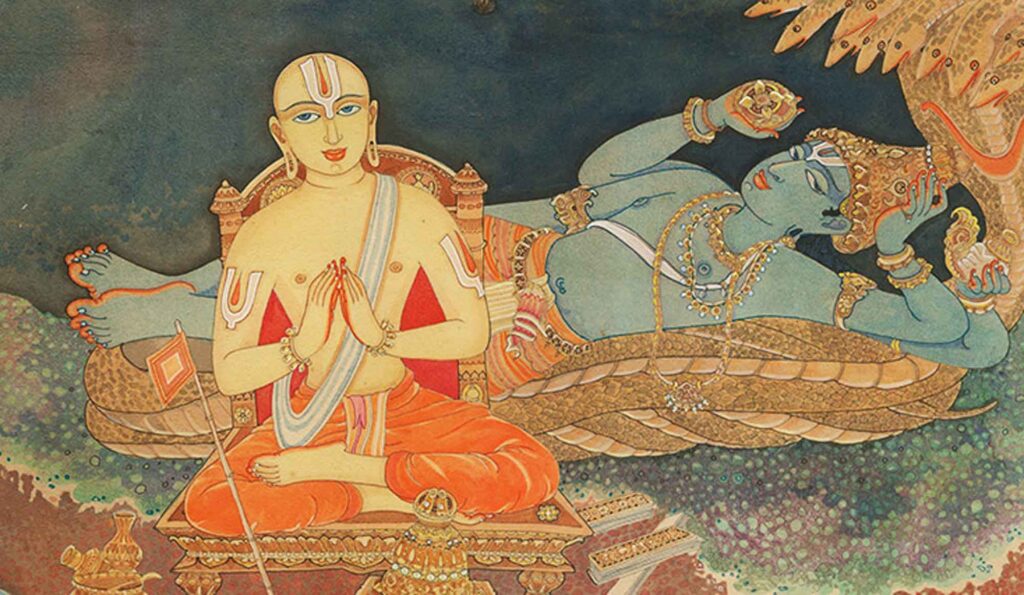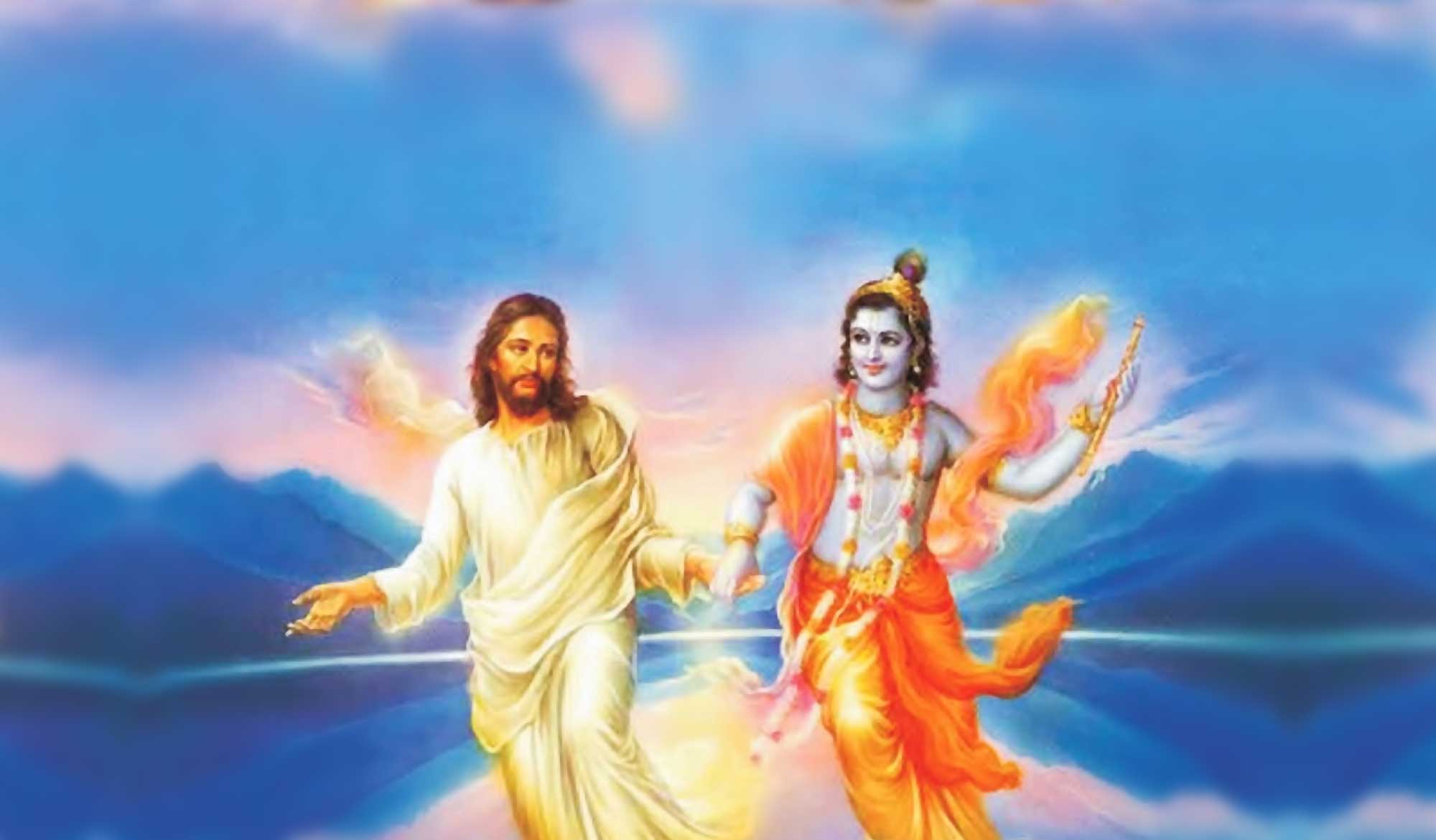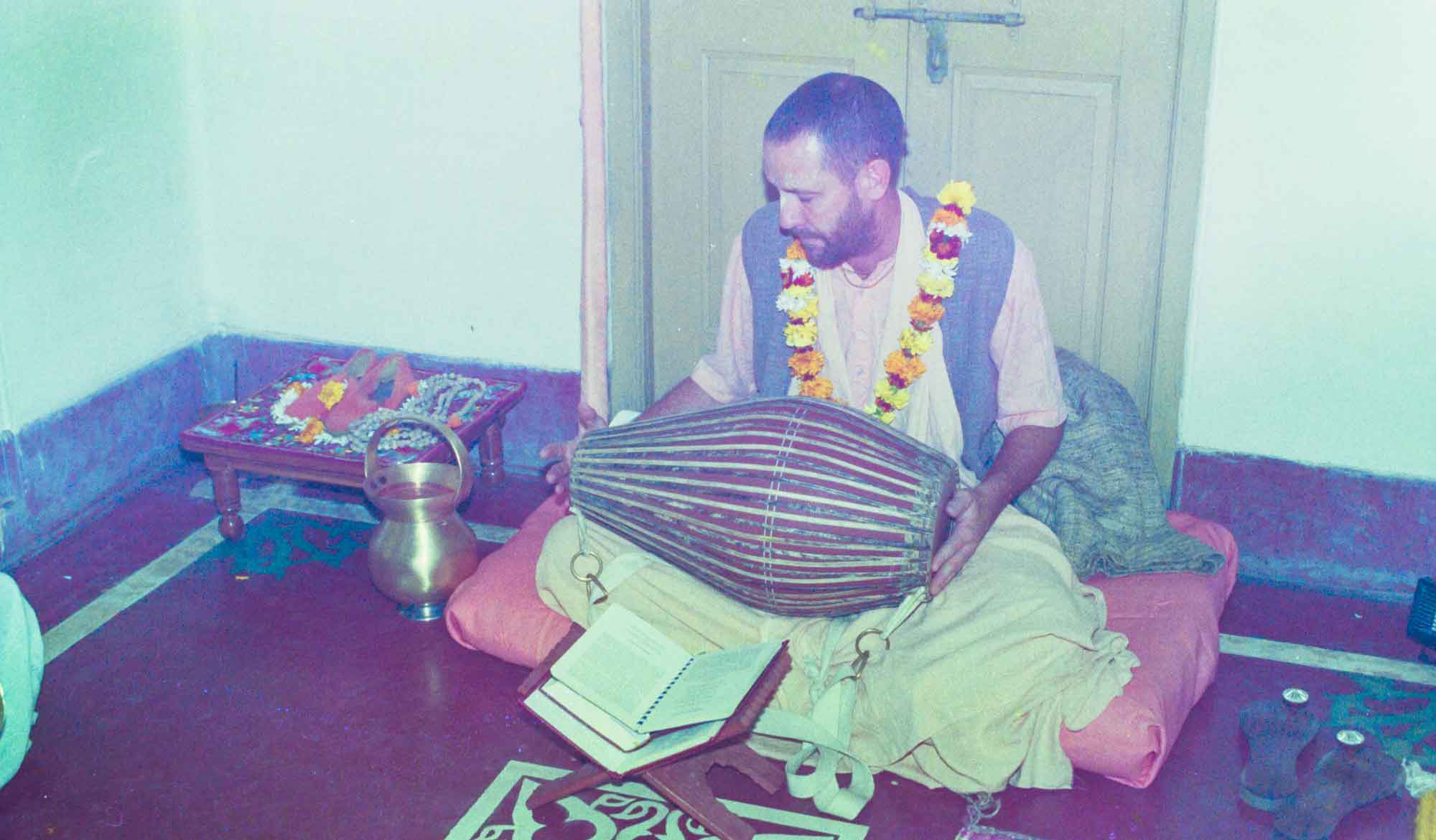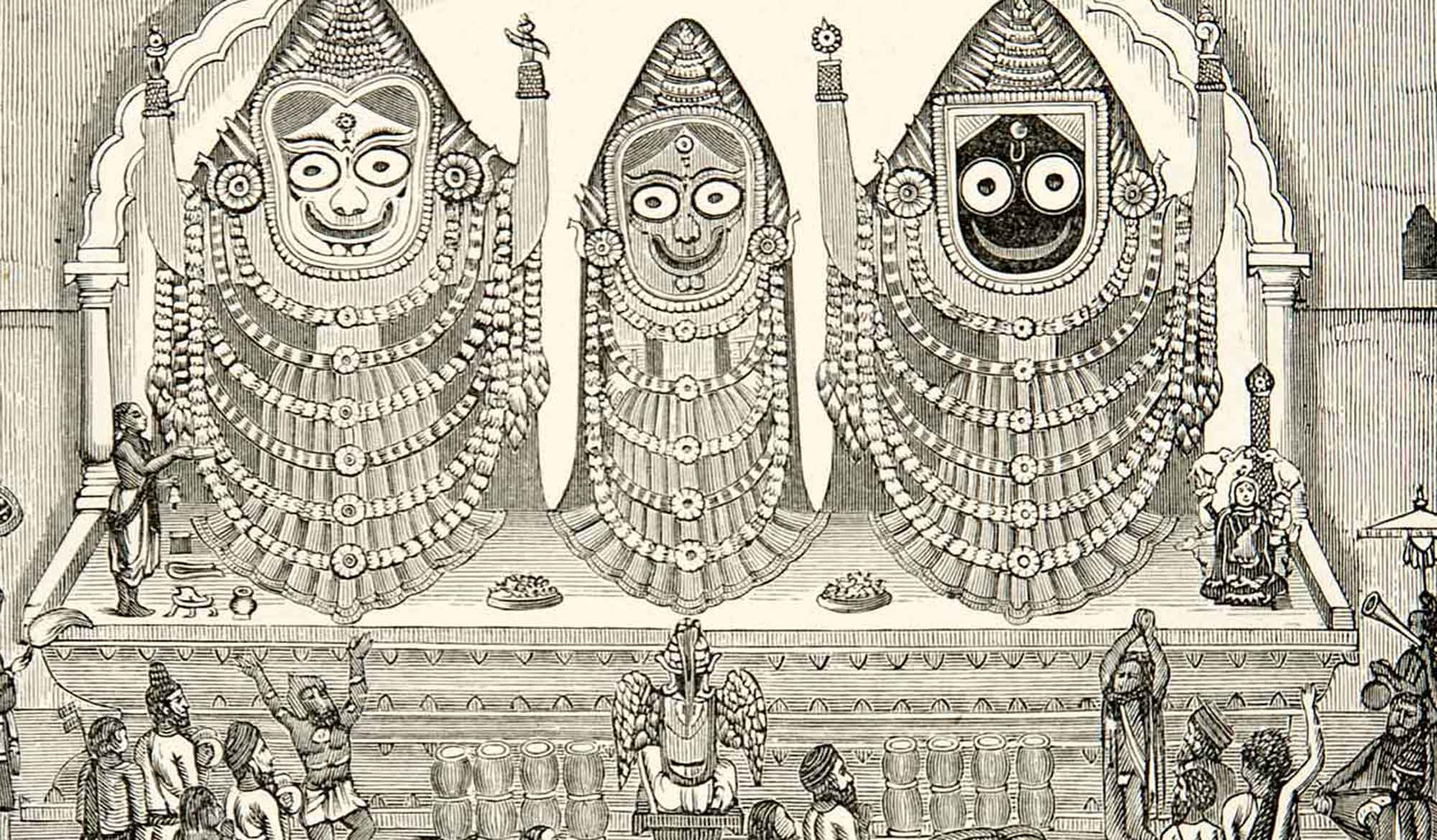by Swami B.G. Narasingha
"The Rāga-Patha is Above All" was written by Swami B.G. Narasingha on May 5th 2008. In this article, Swami Narasingha discusses the verse composed by Śrīla Sarasvatī Ṭhākura, 'Pūjala rāga-patha gaurava bhaṅge', its history, meaning and its significance in connection with Śrīla Śrīdhara Mahārāja.
Question: I have read numerous translations and comments about the ‘pūjala rāga-patha’ verse on the internet and there seems to be a lingering controversy about who wrote the verse, what it means, etc. Can you provide me with a broader overview of the topic so that I might clarify my understanding?”
Swami Narasiṅgha: My answer below may seem a little tedious at times, but if you bear with me on the details you may find what you are looking for.
Regarding the verse that you have quoted, it is part of a six-line Bengali song that reads as follows in the Roman transliteration:
mātala hari-jana viṣaya-raṅge
pūjala rāga-patha gaurava-bhaṅge
bhramala chāḍi’ bhoga cinmaya baṅge
dhāula pathi-pathi bhakata-saṅge
chāḍala para-ghara arccite gaṅge
bujhala rasa-nīti nācata ḍaṅge
The controversy that you speak of, only surrounds the meaning of the first two lines and particularly the second line. As for the translation of lines 3 thru 6, we are not aware that any controversy exists. The translation of the song by our āśrama, Śrī Narasiṅgha Caitanya Maṭha is as follows:
mātala hari-jana viṣaya-raṅge
pūjala rāga-patha gaurava-bhaṅge
“The servants of Hari are engaged in lavish affairs, handling material wealth and engaging all manner of things in the Lord’s service. They worship the path of spontaneous devotion with gaurava-bhaṅge (in a mood of awe and reverence) and to show that the rāga-patha is above all (above our heads), they remain as servants, being a little distant and below, praying for that of a servant’s duty, not for that of a confidential nature — not to bring that highest divine love down here, but to hold that upon their heads.”
bhramala chāḍi’ bhoga cinmaya baṅge
dhāula pathi-pathi bhakata-saṅge
“Having given up all sense-enjoyment, one should wander through the divine land of Gauḍa-deśa, running along the paths and roads in the association of the devotees.”
chāḍala para-ghara arccite gaṅge
bujhala rasa-nīti nācata ḍaṅge
“Leaving that previous house forever to worship the Deity on the banks of the Ganges, one will understand the science of rasa by the process of dancing (i.e. saṅkīrtana).”
The history of this song, its origin, and its later alteration from the original is very interesting. The original author of the song was Śrīla Bhaktisiddhānta Sarasvatī Ṭhākura, who composed the verses in 1930. It was on the occasion of moving the Deities of Śrī Gaurasundara and Śrī Śrī Vinoda-Ānandajiu from the old house at Ultadanga Junction Road to the new temple in Bagh Bazaar, Kolkata. Sarasvatī Ṭhākura especially composed the six-lines of song for the occasion and requested the devotees present to sing it during kīrtana. The day of the procession was Sunday 5th, October 1930.
In that month’s edition of the Bengali magazine Gauḍīya, the six-line song was printed above a photo that showed the ratha of the Deities with Sarasvatī Ṭhākura and the devotees standing in front.
The first two lines of the Bengali read as follows:
mātala hari-jana viṣaya-raṅge
pūjala rāga-patha gaurava-bhaṅge
Herein begins the controversy. The first line reads mātala hari-jana viṣaya-raṅge. In later years, the first line became popular as mātala hari-jana kīrtana-raṅge. The original composition by Sarasvatī Ṭhākura however reads viṣaya-raṅge, and not kīrtana-raṅge. How this came to pass is indeed interesting. But before mentioning how kīrtana-raṅge came to replace viṣaya-raṅge, we should first mention that some leading contemporary Vaiṣṇavas such as Swami B.V. Tripurāri Mahārāja, Swami B.V. Mādhava Mahārāja and others are quite comfortable with the implementation of kīrtana-raṅge. Both these personalities that I have mentioned have at least on one occasion quoted the first line of the song in their writings and discourses as mātala hari-jana kīrtana-raṅge.
Swami B.V. Tripurāri Mahārāja translates the first two lines as:
“The devotees, intoxicated by the kīrtana of the Holy Name that consumes the entire world, worship the rāga-mārga at a distance until the time when by such kīrtana their hearts are cleansed of any charm for the world and the distance between themselves and their Deity is bridged as reverence for the Deity breaks down and is replaced by love.” (Saṅga of Swami B.V. Tripurāri, disciple of Śrīla A.C. Bhaktivedānta Swami Prabhupāda)
Swami B.V, Mādhava Mahārāja translates the same two lines as:
“The servants of Hari revel in the chanting of the Holy Name. They worship the path of spontaneous devotion, whereby awe and reverence is overthrown.” (from the website of Swami B.V. Mādhava, disciple of Swami B.V. Nārāyaṇa Mahārāja)
In our humble opinion, the translation of Swami B.V. Tripurāri Mahārāja is in consonance with a deeper understanding of the verse, whereas that of Swami B.V. Mādhava relies solely on a reading based on the meaning of gaurava-bhaṅge as to ‘overthrow awe and reverence’ as when derived from bhaṅga (breaking or splitting).
However, when it is understood that the root of bhaṅge is actually derived from the noun bhaṅgi (mood, a distinction of style, way or attitude), then gaurava-bhaṅge means ‘in a mood of awe and reverence’. Thus, pūjala rāga-patha gaurava-bhaṅge is to worship the path of rāga-patha with awe and reverence.
In the controversy that we are discussing this is then the ultimate question – when composing the verse pūjala rāga-patha gaurava-bhaṅge, did Sarasvatī Ṭhākura intend gaurava-bhaṅge to mean ‘to break awe and reverence’ or ‘a mood of awe and reverence’? It will be seen later on in this essay that his intention was gaurava-bhaṅge – a mood of awe and reverence.
It has recently been suggested by some devotees that it was Śrīla B.R. Śrīdhara Deva Gosvāmī Mahārāja who changed viṣaya-raṅge to kīrtana-raṅge, but from the history of Śrī Caitanya Sārasvata Maṭha it is said that the disciple of Śrīdhara Mahārāja, namely Śrīpāda B.S. Govinda Mahārāja suggested to Śrīdhara Mahārāja that kīrtana replace viṣaya in order to make the verse more understandable or clear to the devotees. Śrīdhara Mahārāja welcomed the suggestion. Govinda Mahārāja recalls as follows:
“Mātala hari-jana viṣaya-raṅge. Originally Śrīla Bhaktisiddhānta Sarasvatī Ṭhākura made that poetry. Later it became mātala hari-jana kīrtana-raṅge, pūjala rāga-patha gaurava-bhaṅge. kīrtana-raṅge – this word I gave and Śrīla Guru Mahārāja accepted it very happily, ‘You can change this for us.’”
Hence it is engraved on the wall of the nāṭa-mandira at Śrīdhara Mahārāja’s maṭha, mātala hari-jana kīrtana-raṅge, pūjala rāga-patha gaurava-bhaṅge.
The controversy that is addressed in the beginning of this essay is not actually about viṣaya-raṅge or kīrtana-raṅge. The real controversy is about pūjala rāga-patha gaurava-bhaṅge. Does this simply mean as Swami B.V. Mādhava points out that, “they worship the path of spontaneous devotion, whereby awe and reverence is overthrown” or is there another meaning to pūjala rāga-patha gaurava-bhaṅge that suggests a completely different approach to rāga-patha, the path of spontaneous devotion?
We should mention here that contemporary preachers outside the following of Śrīla Śrīdhara Mahārāja rarely, if ever, quote the song we are discussing. In fact, Swami B.V. Mādhava Mahārāja only ever referenced the song that we are discussing as a response to a video production that expressed the opinion of Śrīla Śrīdhara Mahārāja, that rāga-patha is worshipable and should always be kept above our heads.
However, Śrīla Śrīdhara Mahārāja quotes pūjala rāga-patha gaurava-bhaṅge again and again throughout his discourses and in his books. What to speak of those words being engraved on the wall at his maṭha, they are engraved in the core of his heart as the essence of the teaching and mission of Śrīla Bhaktisiddhānta Sarasvatī Ṭhākura.
Śrīla Śrīdhara Mahārāja speaks about the song in question in several places as follows:
“Pūjala rāga-patha gaurava-bhaṅge – composed by Guru Mahārāja himself when from the hired house in Calcutta, the Deities and the maṭha was removed to his own constructed maṭha. The Deities were carried in a chariot and we were dancing and singing just in front of the Deities. At that time he composed some six lines perhaps. ‘You should sing this and direct the chariot from the hired house to our own maṭha.’ Mātala hari-jana visay-raṅge pūjala rāga-patha gaurava-bhaṅge. It is currently seen that the devotees have made themselves mad in handling so much material wealth. Generally the devotees should engage themselves in the subject of the Lord, but here in Gauḍīya Maṭha we find they are handling money, motor car, this, that – everything here, lavishly, viṣaya raṅge. For what purpose? pūjala rāga-patha gaurava-bhaṅge. Gaurava bhaṅge – to show that the rāga-patha is above all. Those that are followers of rāga-patha, their position is very high. Not that they cannot be masters of this mundane world. So, they have left everything and are taking the path of worshiping Him, in their heart. But all this grandeur, all reverence everything should go to serve them. pūjala rāga-patha – everything will have its fulfilment with their connecting in any way with the feet of those that are engaged in their worship exclusive of these worldly things with his heart.” (Darśana with Śrīla Śrīdhara Mahārāja, 14-08-81)
“Pūjala rāga-patha gaurave-bhaṅge — that is always upon our head, that the prospect of our life’s future, life after life, cannot be finished. We shall rather foster the hope, the pure hope that we may be taken in one day in that camp. With this idea.” (Follow The Angels, Part 2)
“But we must be ready to pay for it, and our Guru Mahārāja came for that purpose. pūjala rāga-patha —don’t go hurriedly. Fools rush in where angels fear to tread. That experience is for the highest minded. It is the highest. One must go step by step. If we omit any step, we will be nowhere.” (Follow The Angels, Part 2)
“Pūjala rāga-patha gaurave-bhaṅge — very sweet. The rāga-patha is on the head. We are servants of the rāga-patha. We are in vidhi–mārga, under śāstrika rule. We must live and move under śāstrika rule, and always keep the rāga-patha upon our head. The whole tenor of Guru Mahārāja’s life was such: ‘That is high, very high, and from below we are to honour that.’ We must establish this conception, the proper regard for that higher līlā, throughout the entire world: ‘That is too high.’” (Follow The Angels, Part 2)
“In mādhurya-rasa, the highest conjugal relationship, even Rādhārāṇī’s own tendency is always to serve Kṛṣṇa. Her inclination is towards dāsya-rasa, service. Is sakhya-rasa, intimate friendship with Kṛṣṇa, a very small thing? No, it is too high for me. Pūjala rāga-patha gaurava-bhaṅge. From a distance I want to show my respect to sakhya-rasa, but I really crave dāsya-rasa. That should be the inclination of a real devotee. If we disregard all these things, we are playing like children.” (Follow The Angels Part 2)
“First understand the degree of purity in Kṛṣṇa consciousness. The followers of form are only imitationists; they want only to exploit Mahāprabu and not to serve Him. They are our worst enemies. They are traitors; they have taken the garb of Mahāprabu’s sampradāya, and they are saying something bogus. This is cheap marketing; they are extensively selling adulterated things very cheaply. They have no inner necessity to attain the purest thing (pūjala ragapatha gaurava-bhaṅge). Although he was such an exalted Vaiṣṇava, our Guru Mahārāja never presented himself as a great devotee. He always used to say, ”I am a servant of the servant of the Vaiṣṇavas.” That was his claim. And he would say, “The higher devotees are my guru, they are so exalted.” First come and practice all these things, and then you can hope to reach the goal. It is not so easy, or so cheap.”(Śrī Guru and His Grace, Ch.3)
“And to take our stand in the negative position is the strategy of remaining in the relativity of the highest quarter of service to Kṛṣṇa, Śrīla Bhaktisiddhānta Sarasvatī Ṭhākura once composed a verse expressing the proper attitude. pūjala rāga-patha gaurava bhaṅge, mātala hari-jana viṣaya raṅge. ‘The path of divine love is worshipable to us and should be held overhead as our highest aspiration.’” (Loving Search For The Lost Servant, Ch.6)
“Pūjala rāga-patha gaurave-bhaṅge—the whole tenor of his life was such: ‘That is high, high. And from below we are to honour that.’ We are to establish in the whole world this sort of posing: the proper regard of that higher līlā, ‘That is too high.’”
“Pūjala rāga-patha gaurave-bhaṅge, Guru Mahārāja, Śrīla Bhaktisiddhānta Sarasvatī Ṭhākura, preached exclusively this mādhurya-rasa, but with great precaution. What is not that thing, he used perhaps 90% of his energy to point out the negative side —‘This is not mādhurya-rasa’— and clear away the negative side. He had to spare, in his words, ‘gallons of blood to establish what is not that māhurya-rasa.’” (Darśana with Śrīla Śrīdhara Mahārāja, 14-08-81)
Śrīla Śrīdhara Mahārāja preached extensively from the verses of the song that is under discussion and supported the idea that gaurava-bhaṅge is derived from the root bhaṅgi. Thus gaurava-bhaṅge means a mood of awe and reverence — of this there can be no doubt. And that Śrīdhara Mahārāja represented the adage: “An ounce of prevention is worth a pound of cure” in his explanations, also goes without question.
Equally, we can say that since the time of Śrīla Bhaktisiddhānta Sarasvatī Ṭhākura no second person has given a clearer or more pronounced understanding of the pūjala rāga-patha verse than Śrīla Śrīdhara Mahārāja. His depth of understanding was profound and his respected godbrothers never hesitated to accept his deep realizations. As Sarasvatī Ṭhākura had said of Śrīdhara Mahārāja, “At least one man is left behind who will be able to represent my conceptions.”
This brings to mind a pastime that occurred in the time of Śrī Caitanya Mahāprabu during the annual Ratha-yātrā festival in Purī. During the procession Caitanya Mahāprabu sang a verse from the Kavya-prakāśa of Śrī Mammaṭa as follows:
yaḥ kaumāra-haraḥ sa eva hi varas tā eva caitra-kṣapās
te conmīlita-mālatī-surabhayaḥ prauḍhāḥ kadambānilāḥ
sā caivāsmi tathāpi tatra surata-vyāpāra-līlā-vidhau
revā-rodhasi vetasī-taru-tale cetaḥ samutkaṇṭhate
“That very personality who stole away my heart during my youth is now again my master. These are the same moonlit nights of the month of Caitra. The same fragrance of malatī flowers is there, and the same sweet breezes are blowing from the kadamba forest. In our intimate relationship, I am also the same lover, yet still my mind is not happy here. I am eager to go back to that place on the bank of the Reva under the Vetasi tree. That is my desire.’” (Caitanya-caritāmṛta. Madhya-līlā 13.121)
Taken at face value (mukhya-vṛtti), the devotees could not understand the internal purpose of the Lord. However, Śrī Rūpa Gosvāmī, being a super calibre devotee could understand the Lord’s internal purpose (gauṇa-vṛtti) and thus he composed another verse revealing the Lord’s heart.
priyaḥ so’yaṁ kṛṣṇaḥ saha-cari kuru-kṣetra-militas
tathāhaṁ sā rādhā tad idam ubhayoḥ saṅgama-sukham
tathāpy antaḥ-khelan-madhura-muralī-pañcama-juṣe
mano me kālindī-pulina-vipināya spṛhayati
“My dear friend, now I have met My very old and dear friend Kṛṣṇa on this field of Kurukṣetra. I am the same Rādhārāṇī, and now We are meeting together. It is very pleasant, but still I would like to go to the bank of the Yamunā beneath the trees of the forest there. I wish to hear the vibration of His sweet flute playing the fifth note within that forest of Vṛndāvana.” (Caitanya-caritāmṛta. Madhya-līlā 1.76)
In this way we cannot help but express our conviction that when Sarasvatī Ṭhākura composed the six-line poem for the ratha festival of the Deities in Kolkata in 1930, that Śrīla Śrīdhara Mahārāja being a super calibre devotee, dear to Śrī Rūpa Gosvāmī, could unequivocally understand the internal purpose of his Guru Mahārāja. Thus it is our lasting determination that the explanation of the pūjala rāga-patha verse as given by Śrīla Śrīdhara Mahārāja should be accepted in the hearts of all the devotees desiring to follow in the footsteps of Śrīla Bhaktisiddhānta Sarasvatī Ṭhākura.
More Articles by Swami B.G. Narasingha
The Aquarian Gospel of Jesus Christ
The article, “The Aquarian Gospel of Jesus Christ” was written by Śrīla Narasiṅgha Mahārāja under the pseudonym of ‘Pradeep Sharma’ in 2007. This article was in response to various parties begging the question about Jesus being a devotee of Kṛṣṇa and citing a dubious work called the ‘Aquarian Gospel’ as evidence.
Meditation Techniques and the Holy Name
'Meditation Techniques and the Holy Name' was written by Swami Narasingha in October 2006. Narasingha Maharaja discusses the age-old problem of distraction during japa, and gives advice based upon Sanātana Gosvāmī and Bhaktivinoda Ṭhākura on how to combat this.
The Burning Cross – Part 2
In ‘The Burning Cross - Part 2’, Śrīla Narasiṅgha Mahārāja, under the pen name of Pradeep Sharma, discusses the Goan Inquisition, how the Christians viewed Lord Jagannātha in Purī, and the thoughts of the Founding Fathers of the Unites States about Christianity.

